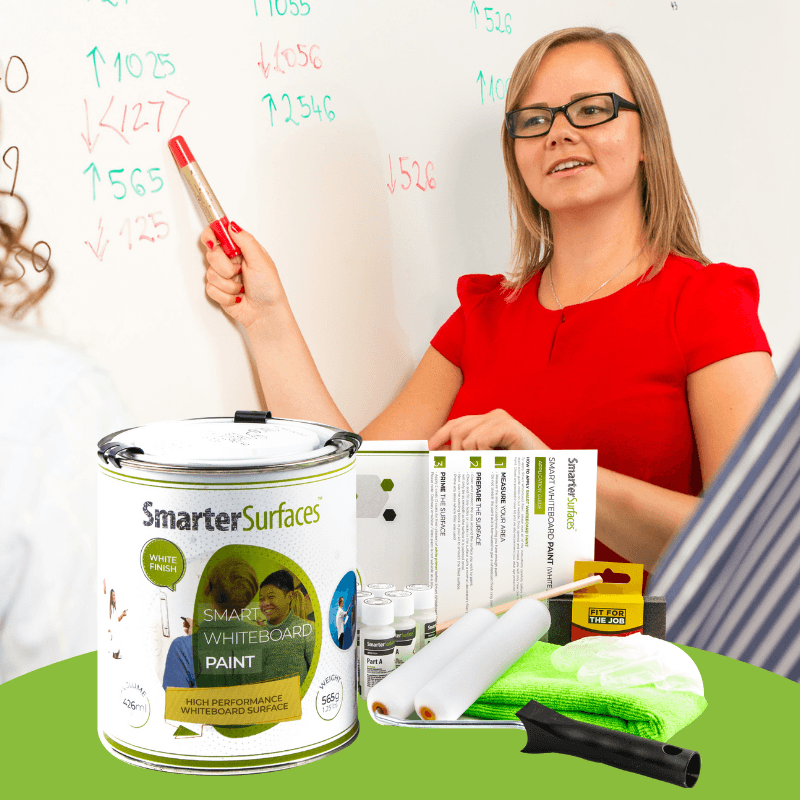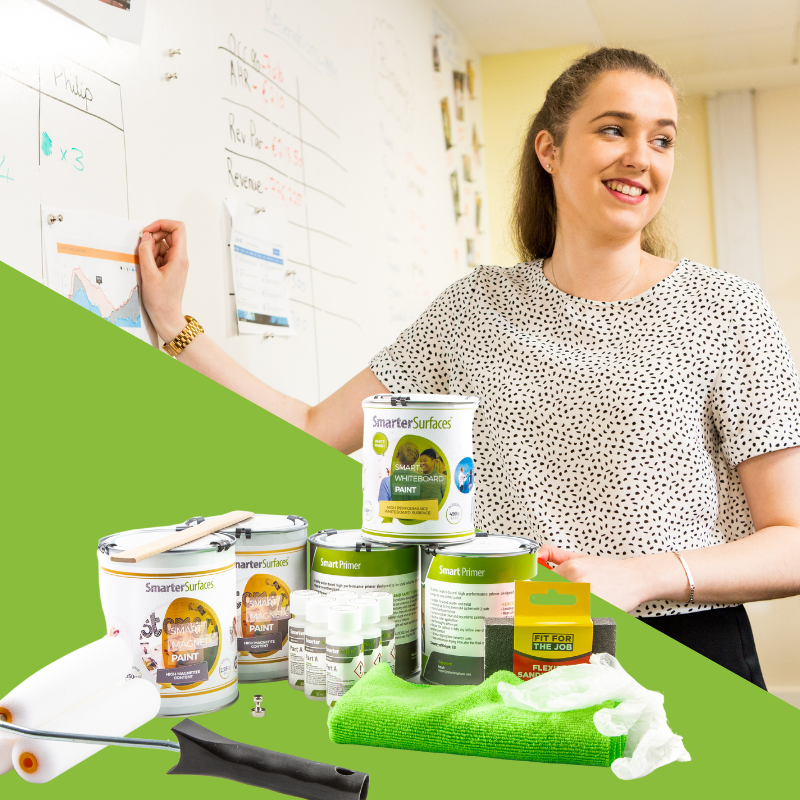Glassboard vs Whiteboard – Which One is Best for Your Office?
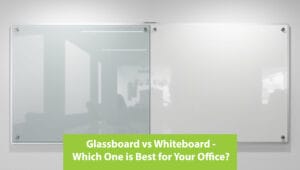
When it comes to modern office environments, writable surfaces play an essential role in driving collaboration, idea generation, and productivity. Whether used for brainstorming sessions, project planning, or presentations, having the right surface can make all the difference. The debate of glassboard vs whiteboard has become increasingly relevant as businesses look for professional, cost-effective, and sustainable solutions.
Glassboards, often praised for their sleek and contemporary design, appeal to companies that prioritize aesthetics. Whiteboards, on the other hand, are valued for their practicality, flexibility, and affordability. With innovative solutions such as Whiteboard Paint from Smarter Surfaces, traditional limitations of framed boards have been eliminated, giving companies the option to create full-wall writable areas.
This guide provides a comprehensive comparison of glassboards vs whiteboards, examining differences in design, usability, durability, and cost. By the end, you’ll have the clarity to choose the best solution for your office.
Difference Between a Glassboard and a Whiteboard
While both surfaces serve the same primary purpose, providing a space for writing and collaboration, they differ significantly in installation, design, and customization. Glassboards are manufactured using tempered glass, making them strong yet heavy. They often require professional installation, as even a small mistake during mounting can compromise safety and functionality.
Whiteboards, in contrast, are more versatile. Traditional framed whiteboards are common, but modern alternatives, such as Whiteboard Paint, allow you to convert any smooth wall, desk, or door into a writable surface. The flexibility of applying whiteboard paint in white or clear finishes also allows integration into any office design. Unlike glassboards, which come in fixed dimensions, painted whiteboards can cover an entire wall, offering far greater scalability.
Limitations of Glassboards in Office Environments

Glassboards offer a stylish and premium look, but they do come with certain limitations that must be considered before purchase. Installation and joints in larger surfaces is one of the biggest challenges. Due to their weight, glassboards require multiple people and precise alignment for safe mounting. Incorrect installation can lead to instability or, in rare cases, breakage. Large glassboards are not practicle to transport so for larger surfaces jointed boards cannot be avoid and this is not ideal.
Transporting glassboards is difficult and costly. Even though tempered glass is strong, it can still shatter under impact. This makes moving them between locations inconvenient. Cost is another concern, as glassboards tend to be significantly more expensive than whiteboards or whiteboard paint solutions but they do perform well in terms of ghosting.
For offices seeking functionality and cost savings, these limitations often make glassboards less suitable compared to alternative solutions.
Advantages of Whiteboards and Whiteboard Paint

Whiteboards remain the most practical choice for offices that prioritize usability and efficiency. Unlike glassboards, they are available in a wider variety of formats, from framed panels to full-wall installations with whiteboard paint. This makes them highly adaptable for different room sizes and business needs.
With Smarter Surfaces Whiteboard Paint, offices can create writable surfaces of any size, transforming standard walls into collaborative spaces. Available in white and clear finishes, it allows seamless integration into both modern and traditional office designs. The paint is easy to apply, requiring just a single coat, and is ready to use within four days.
Durability is another advantage. High-quality whiteboard paints exceed international environmental standards and come with long guarantees, ensuring ghost-free performance over many years at a pricepoint well below glassboards but like for like excluding cost glassboards are more durable. For businesses, this translates into lower replacement costs and uninterrupted productivity.
Take your setup to the next level. Explore our range of products and find the perfect solution for you.
i wish i had thought of these guys before wasting money on rubbish alr screens, would def recomend and will use this paint again if needed in future.
I am Ash, owner of LEC Company. We ordered this whiteboard paint and found this as an amazing product so far we have used other paints. It's is innovative and quality is absolutely perfect. I recommend this product to my customers now. Smarter Surfaces team takes their customers very seriously and understand their needs. I have an amazing experience with Smarter Surfaces.
Thank you
We bought this Smart Projector Paint Pro to paint a wall in our community centre. It is fantastic! Everyone who uses the room, including the local camera club, have said how clear and crisp the images are. No need for an expensive projector screen the wall IS the screen. It is slightly pricey but well worth it. It has painted the whole wall. Highly recommend this product. Its so good we are buying more to paint screens in other rooms. Excellent product and an excellent customer service and communication. Brilliant!
For the rooms for which I bought the super magnetic paint, the result obtained was excellent, just what I wanted. The photos speak for themselves, and we are only at the beginning!
Overall, however, I absolutely recommend the smarter surfaces products. With them I was able to realize the ideas I had in mind and make my son enthusiastic!
Advantages of a White Glass Board
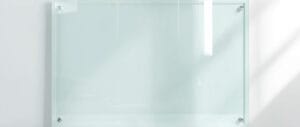
While clear glassboards can sometimes create visibility challenges due to their transparent nature, white glassboards offer a more practical solution. They provide the same sleek and modern aesthetic of glass while ensuring better contrast for markers. This makes writing more visible, particularly in large meeting rooms.
White glassboards are also durable and present a professional look that appeals to many corporate settings. However, they are still limited in size, as they come in pre-manufactured panels. For businesses that want the design appeal of a white glassboard without its constraints, whiteboard paint can serve as a strong alternative. It delivers the same clean, modern appearance while offering full customization at a lower cost.
Ghosting, Maintenance, and Durability: Glassboard vs Whiteboard
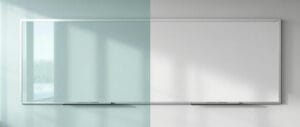
One of the most common concerns with writable surfaces is ghosting, the faint marks left behind even after erasing. Glassboards are often marketed as ghost-resistant, but if markers are left on for extended periods, stains can still develop. Regular cleaning is essential to maintain their polished appearance.
Premium whiteboard solutions such as Smarter Surfaces Whiteboard Paint provide a guaranteed ghost-free experience similar to Glassboards. With independent certifications and a 10-year performance guarantee, businesses can rely on consistent, high-quality performance without worrying about staining.
Aesthetics and Functionality in Workspaces
Aesthetics often play a key role in office design decisions. Glassboards are favored for their glossy, frameless design that creates a modern impression. They are often chosen for executive boardrooms or client-facing spaces where design is prioritized.
However, functionality should not be overlooked. Matte Whiteboard Paint from Smarter Surfaces addresses both aesthetic and functional needs by reducing glare, ensuring readability under different lighting conditions, and even doubling as a projection surface. This combination of features makes it highly practical for meeting rooms, classrooms, and offices where presentations and brainstorming sessions are frequent.
The big drawback for glass is the the fact large surfaces will require significant amount of jointed boards.
Magnetic Capabilities Compared

Magnetic functionality can enhance collaboration by allowing users to attach notes, charts, and reference documents alongside their writing. Glassboards do offer magnetic options, but the strength is typically weaker and depends on additional accessories.
Whiteboard solutions, on the other hand, can be easily combined with magnetic capabilities. With Magnetic Whiteboard Paint or a combination of Magnetic Plaster with Whiteboard Paint, surfaces gain strong magnetic pull and dry-erase functionality. This dual-purpose solution is particularly useful in offices where planning and brainstorming require both writing and pinned materials.
Cost-Effectiveness and Sustainability: Glassboard vs Whiteboard for Office
Cost is a decisive factor when comparing glassboards and whiteboards. Glassboards come with a high initial price tag, alongside installation and transport costs. Their fixed sizes also mean multiple boards may be required to cover larger spaces, further increasing expenses.
Whiteboards, particularly paint solutions, provide a more cost-effective approach.
By converting an entire wall into a writable surface, businesses achieve more functionality at a fraction of the cost. The long lifespan and low maintenance requirements further enhance their value.
From a sustainability perspective, whiteboard paint reduces the need for paper in brainstorming sessions and minimizes waste associated with replacing traditional boards. This makes it an environmentally responsible choice for companies committed to greener practices as whiteboard paint never goes to landfill where boards at end of life do.
Glassboard vs Whiteboard Paint: Pros and Cons
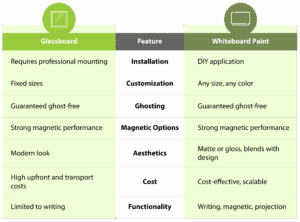
How to Choose Between Glassboard and Whiteboard
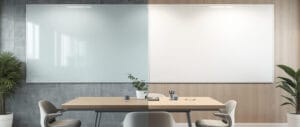
The decision between a glassboard and a whiteboard depends on your office priorities. If design aesthetics and a premium appearance are your main goals, a glassboard for wall may fit well, particularly in spaces where presentation is key. However, the cost, installation challenges, and size limitations must be factored in.
If your focus is on functionality, cost-effectiveness, and long-term usability, a whiteboard, especially in the form of paint, provides more advantages. It allows you to maximize collaboration space, integrate magnetic and projection features, and maintain a professional look without the high expense of glassboards. For most modern offices, whiteboard paint strikes the right balance between performance and value.
Final Thought
In the glassboard vs whiteboard comparison, both options have their place in professional environments. Glassboards deliver sleek aesthetics and durability but are costly and less flexible. Whiteboards, particularly paint solutions, provide scalability, ghost-free performance, magnetic options, and cost-effectiveness, making them the smarter choice for most offices.
Smarter Surfaces offers a range of whiteboard solutions tailored to office needs, from Whiteboard Paint to Magnetic and Matte finishes. By choosing the right writable surface, you can transform your workspace into a hub of collaboration, innovation, and productivity.

